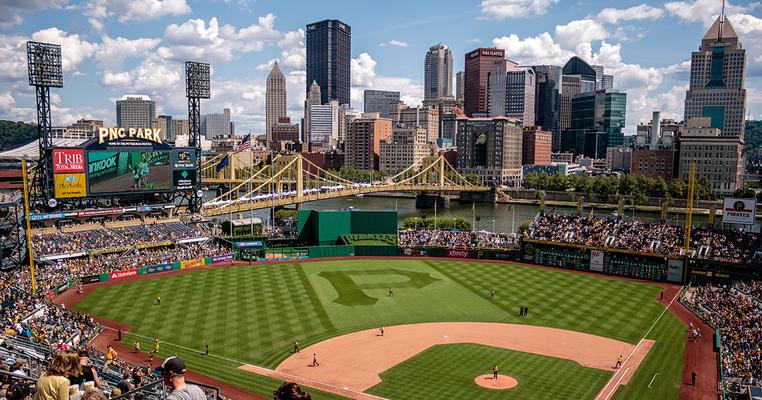
How Pittsburgh is Taking Climate Action
Until earlier this summer, the city of Pittsburgh may not have come immediately to mind when you thought of major cities leading the climate fight. Indeed, anyone outside of western Pennsylvania could be forgiven for having a dated idea about Steel City. Its very name calls to mind blast furnaces bellowing clouds of smoke into the air. Then there’s the “Pittsburgh coal bed,” the thickest and most extensive coal bed in the Appalachian Basin.
There’s a reason for this perception of the city. Thanks to all the industry in the region, by the 1940s, the air was so heavy with soot and smog and smoke that the city’s streetlamps remained lit 24 hours a day. And by the early 80s, as Pittsburgh was weathering the fall of its steel industry and the closure of coal mines, the adjusted unemployment rate hit a devastating 17.1 percent in the greater metropolitan area.
This was the Pittsburgh President Trump evoked from the White House Rose Garden on June 1 as he announced his decision to withdraw the US from the Paris Agreement, declaring he represented the citizens of “Pittsburgh, not Paris.” But the citizens of today’s Pittsburgh, who’ve spent the last three decades remaking their city into a multi-industry hub for education, healthcare, technology, and sustainable development, weren’t sure what he was talking about.
With just three words, Pittsburgh was thrust into the center of the global climate fight. And boy, did it come out swinging.
Clean energy has played a central role in Pittsburgh’s amazing transformation. Today, Allegheny County, home to Steel City, leads the state of Pennsylvania in clean energy jobs, and more than 13,000 of Pennsylvania’s 70,000 workers employed in the clean energy sector – more people than work in coal, oil, and natural gas combined – call the city itself home.
This commitment begins with the buildings that shape Pittsburgh’s glorious skyline (above). The city was at the forefront of the green building revolution and today boasts hundreds of LEED-certified developments. These include two of the first 12 green buildings certified in the nation, as well as the first green convention center, university dormitory, and financial institution.
The Center for Sustainable Landscapes at Phipps Conservatory (below), a lush botanical garden in the city’s Schenley Park, generates all of its own energy and treats and reuses all water captured on site. The Conservatory is recognized as one of the world’s greenest buildings.The Pittsburgh 2030 District is, according to the city’s website, “a collaborative, nationally recognized, but local community of high performance buildings in Downtown and Oakland that aim to dramatically reduce energy and water consumption, transportation emissions, and improve indoor air quality while increasing competitiveness in the business environment and owner's returns on investment.”
Today, the district boasts 438 buildings.
Construction is only part of the story, however.
After the president’s “Pittsburgh, not Paris” statement, Pittsburgh Mayor Bill Peduto immediately fired back that his city would uphold its commitments to the goals of the Paris Agreement. In a fiery op-ed in the New York Times, co-written with Paris Mayor Ann Hidalgo, he noted that “[i]nvestments in smart infrastructure, bike sharing programs, new mass transit options, and building efficiency” have put the city on track to meet its goal of slashing greenhouse gas emissions by 20 percent by 2023. He also reaffirmed that Pittsburgh would be 100 percent powered by renewable energy by 2035.
One reason the mayor is so confident is that the city’s rich history of energy production and exceptional engineering programs has made it a national center for innovation. Pittsburgh is a US Department of Energy “Solar America City” and manages the Western PA Energy Consortium, a region-wide energy cost and consumption reduction program that has bought at least 25 percent of its electricity needs from green sources.
Today, tech giants like Google, Apple, Facebook, Uber, and IBM feel right at home in the city. As do leading research organizations like Carnegie Mellon University and the University of Pittsburgh. These days, it regularly ranks highly among the top places to live, work, and visit in the United States.
Why Does Al Gore Wear a Green Ring Pin?
And that’s why Pittsburghers clapped back so furiously when the president used their city as an example of a place that would be doomed by shifting to clean energy. With three little words – “Pittsburgh, not Paris” – he proved exactly how little he knew about their city and why it’s flourishing – or perhaps even that it is flourishing at all.
In Pittsburgh, sustainability goes hand-in-hand with design, urban planning, and rejuvenation, and the city has become a model of a post-industrial renaissance. By shaking loose from its polluted past and continuing down the path of sustainability and innovation, Pittsburgh is thriving proof that an economy, culture, and an entire city can be reborn for a low-carbon future.
What Can You Do to Help Solve the Climate Crisis?
If you’d like to learn more about what you can do to solve climate change, join us for our next Climate Reality Leadership Training.
The program takes great leaders and makes them exceptional, providing training in climate science, communications, and organizing in order to better tell the story of climate change and inspire communities everywhere to take action.


